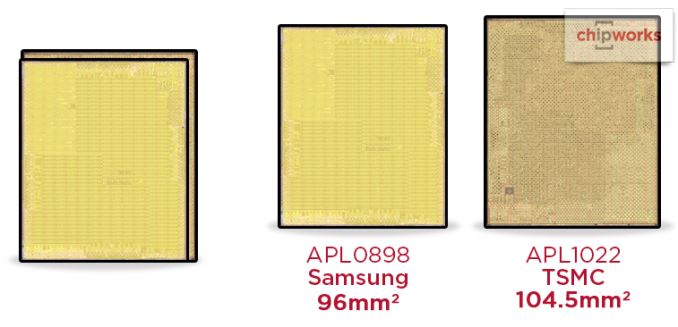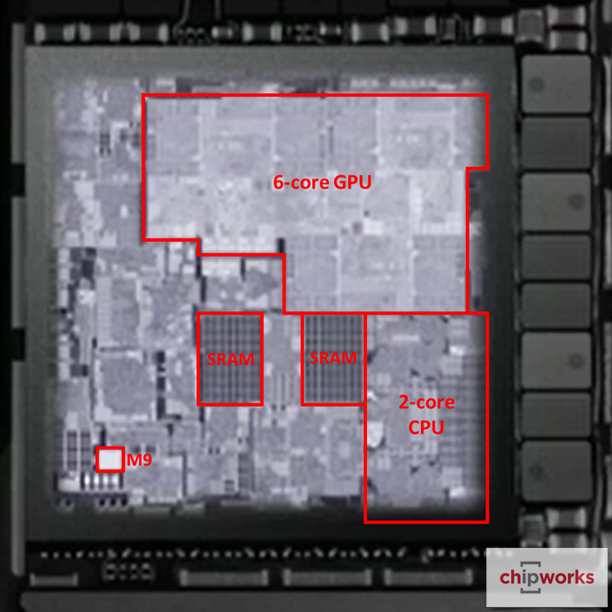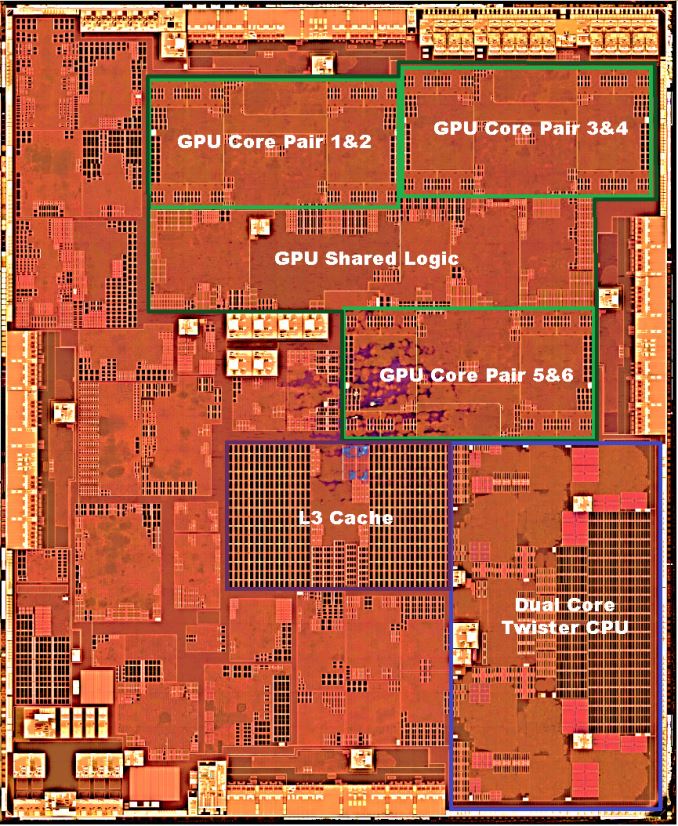The Apple iPhone 6s and iPhone 6s Plus Review
by Ryan Smith & Joshua Ho on November 2, 2015 8:00 AM EST- Posted in
- Smartphones
- Apple
- Mobile
- SoCs
- iPhone 6s
- iPhone 6s Plus
Dual Sourcing A9: Two for the Price of Two
Perhaps more remarkable than the fact that the A9 is built using a FinFET process however is who it is being built by. For the first time Apple is dual sourcing the SoC – rather than using TSMC or Samsung exclusively, they are using both.
Broadly speaking, dual sourcing is a practice that has fallen out of style as the number of contract semiconductor manufacturers has dwindled and the cost of chip production has gone up. Because each manufacturer has its own rules and own best practices, to dual source a chip involves designing it twice, once for each manufacturer. This has made the cost of dual sourcing increase over time, and consequently dual sourcing falling out of fashion.
This of course is a big part of what makes Apple’s decision to dual source so unexpected. Apple is taking a much bigger gamble this time around by dual sourcing than they have on past SoCs where it was produced by a single manufacturer (be it TSMC or Samsung). Dual sourcing means that Apple’s costs to tape-out and bring-up A9 have very nearly doubled; they have to tape-out each version of the A9 for the respective fab’s rulesets, and then they have to go through the bring-up process with each in order to dial-in the yields and clockspeeds. They at least get to reuse the underlying architecture (e.g. Twister CPU and their PowerVR GPU), but actually creating a chip design for each fab is a significant part of the development costs for A9.

Samsung vs. TSMC A9 Die Size (Image Courtesy Chipworks)
The end result then is two similar but not quite equal chips that are produced by TSMC and Samsung respectively. Both are A9s, both feature the same CPU, GPU, memory interface, and all of the other bits that make up an A9. But each is produced at a different fab, according to the rules of that fab.
One of the immediate ramifications of dual sourcing is that the die sizes of the A9s are different. The A9 produced by Samsung on their 14nm FinFET Process is the smaller of the two, at 96mm2. Meanwhile the A9 produced on TSMC’s 16nm FinFET process is 104.5mm2, making it about 9% larger. Though not an immense difference in size (and not that we’d expect otherwise) there are tradeoffs to be had. With all other things held equal, the larger TSMC die would produce fewer complete dies per 300mm wafer, and any given die is more likely to have an imperfection since there are fewer dies for the same number of imperfections. This gives the Samsung A9 a slight edge in manufacturing thanks to its better density, however it’s equally important to note that in the real world there are a number of factors at play here, including manufacturing yields at each fab and how much each fab is charging Apple, so while the Samsung A9 is the smaller A9 it isn’t necessarily the cheaper A9.
The bigger question on many minds is whether there’s a performance difference between the two A9s. We wrote a bit on the subject a few weeks back, and the short answer is that it’s very difficult to tell. Due to chip quality being a distribution no two phones utilizing the same A9 are the same, and that means just comparing any two phones can’t tell us the whole story. Ultimately what one needs is a large number of phones to find the distribution, the median of that distribution, and how the medians compare. This is something that if done perfectly would require thousands of phones, and is really only possible for Apple or the competitive analysis teams at their well-funded competitors.

Apple A9 Die Shots (Image Courtesy Chipworks Teardown Report)
At this point then we don’t have anything new to add to the discussion – we don’t have enough data – though it is still a matter we are working on. Sometimes the best thing we can do is say is when we don’t have enough information, rather than extrapolating too much from too little information. I will note however that it’s ultimately in Apple’s best interests for the A9s to be as similar as possible, and there are steps they can take to ensure that, particularly in selecting which chips they will use.

Current A9 Chip Manufacturer Distribution (Image Courtesy Hiraku)
Meanwhile looking at the data collected by iOS developer Hiraku’s CPU Identifier project, it’s interesting to note that of the 250K+ phones sampled so far, the Samsung A9 is in 63% of those phones, giving us a Samsung-to-TSMC ratio of nearly 2-to-1. This survey should not be considered the final word in the ratio between the two A9s since it can change over time and an opt-in survey of this fashion has an inherent self-selection bias, but with so many results it should be a reasonably accurate summary of the current situation.
What remains to be seen – and likely never to be answered outside the walls of One Infinite Loop – is why Apple dual sourced in the first place. We can certainly speculate on reasons they would do this – yield issues at a fab, a desire to avoid putting all of their eggs in one basket and giving one fab too much power, or even just wanting to ramp up A9 production quickly by doubling the number of fabs working on it. What is apparent however is that with Apple selling 48M iPhones in Q3’15 (note that the majority of these were not 6ses), A9 is a uniquely good candidate for dual sourcing. Apple sells enough iPhones that their large pile of cash aside they can absorb the cost of dual sourcing by spreading out the costs over tens of millions of high-margin chips, and if yields/supply were a factor in this decision then that’s all the more reason to dual source. This in turn makes me wonder if we’ll see Apple continue this strategy given their enormous volume, or if this was a one-time event due to the early nature of FinFET, leading to them settling on a single fab for the iPhone 7 launch.
Die Size: Hitting the Sweet Spot
Finally, before jumping into our discussion of the A9’s CPU and GPU, let’s talk about A9’s die size in a historical context. Unlike the transition from A7 to A8, Apple doesn’t get the advantage of a substantial transistor density improvement going from A8 to A9. To use TSMC as an example here (since they produced A8), their 16nm FinFET process is advertised as having 2x the density as their 28nm process, however compared to that same 28nm process their 20nm process had a 1.9x density advantage. In other words, the transition from 20nm HKMG planar to 16nm FinFET does not bring with it the same kind of density improvements we’ve seen in the last few generations.
In fact the only other time Apple has not had the advantage of a density improvement is the transition from A4 to A5, which saw Apple’s die sizes transition from what remains their smallest die to their largest die, all in a single generation. For A9 then Apple has to work smarter, as they can’t add a large number of transistors relative to A8 without ballooning A9’s die size outside of Apple’s sweet spot (and harming chip yields at the same time).
| Apple SoC Evolution | |||
| Die Size | Transistors | Process | |
| A5 | 122m2 | <1B | 45nm |
| A6 | 97mm2 | <1B | 32nm |
| A7 | 102mm2 | >1B | 28nm |
| A8 | 89mm2 | ~2B | 20nm |
| A9 | 96mm2/104.5mm2 | >2B | 14nm/16nm |
Consequently the A9s that we’re getting are surprisingly conservative. The TSMC A9 is 104.5mm2, some 17% larger than the TSMC A8. Meanwhile the Samsung A9 is the smaller of the two at 96mm2. The TSMC A9 is now Apple’s second-largest non-X SoC, but just barely so; it’s only 2.5mm2 larger than the A7. Otherwise with an average die size of 100mm2, this puts the A9 at the upper-bounds of Apple’s sweet spot.
Yet despite the limited gains in transistor density versus A8, Apple has managed to “bulk up” their SoC design by quite a bit. We’ll go over this in greater detail on the following pages, but of particular note is that Apple is now implementing what we believe to be a 6 core PowerVR GPU design, and Apple has significantly increased both the L2 and L3 cache sizes. Coupled with this is the jump to LPDDR4 (requiring more complex memory controllers) and numerous smaller improvements we’ll likely never learn about. The number of CPU cores remains unchanged at 2 however.

Chipworks' Initial Layout Analysis (Image Courtey Chipworks)

My Layout Analysis For A9 (Die Shot Courtesy Chipworks)
On a final note, now that we have die shots of both A9s from Chipworks, I must tip my hat towards Apple for releasing an accurate die shot of what we now know is the Samsung A9 in their iPhone 6s presentation. Up until now Apple has never released their own die shot of their SoCs, and in fact first-party die shots are becoming increasingly rare as a whole in the semiconductor industry. Consequently I had expected that Apple’s die shot was a fake, only to be far more impressed that it’s real. Furthermore despite the low resolution of the shot, Apple’s false color and contrast enhancements make it surprisingly clear where the CPU and GPU blocks are, and how many of each there are. This is a level of contrast that even the Chipworks shots can’t quite match this time around.











531 Comments
View All Comments
Mummiez - Saturday, December 26, 2015 - link
There is also a video on YouTube showing a dancing man wearing a horse mask. Even more amusingly, I must add.https://www.youtube.com/watch?v=ffDPTKn7HiY
mike3332015 - Saturday, November 7, 2015 - link
if this gets the second highest award then can someone tell me what got the first highest award?TechnologyGuy - Saturday, November 7, 2015 - link
Good review but as many have pointed out, as is customary at Anand, very biased in favor of Apple products. Over-reaching statements are used throughout the article and the conclusions simply don't follow from the evidence. No doubt the 6s is one of the top smartphones on today's market but it lags in camera performance (Z5, S6, G4, P6 are all better) and the poor screen is simply unacceptable by today's standards (no, the dpi is high enough argument holds no water; at least for me I can tell at a first glance when compared to other phones). Software is of course more subjective and for normal usage, there is no clear winner between iOS and Android. Stability is non-argument as I have had far more issues on my iPhones than my Galaxy S6, not to mention having to fix my GF's phone after iOS 9 bricked it. Lack of customization in iOS (short of jailbreaking which is still limiting) is also a deal-breaker for those of us who care.So is it a good phone? Sure I'd agree. But it's far from the leaders in the market today and to claim such is simply false.
ciderrules - Saturday, November 7, 2015 - link
Yet another person upset at the cold, hard, fact that Apple is killing it with fantastic hardware.TechnologyGuy - Sunday, November 8, 2015 - link
Fantastic hardware? I guess you didn't even read my comment. The SoC is a very nice engineering achievement but it does nothing to alter my user experience as a power user. The features I personally require are simply subpar in today's flagship market (camera & screen as I have clearly pointed out).There is nothing to be upset about - Apple has come up with a very nice product that fits well into the top end of the market but there is no question it misses the mark in several areas, at least for users like myself. I am more disappointed in the biased nature of the review than the actual product.
ciderrules - Sunday, November 8, 2015 - link
Power user? iOS users are the true power users as they actually can choose from high-end software to do real work on their devices. Or do you think widgets or minor customization makes you a power user?Oh, and saying Anand is biased? Typical response from people who dislike Apple and are having trouble trying to accept they make the best smartphone.
TechnologyGuy - Monday, November 9, 2015 - link
Why would I accept that Apple makes the best smartphone when the company does not? Blind favoritism serves no purpose in the tech world. For that matter, I do not think any company makes the "best" products. Such a term is irrelevant and frankly counter productive. I expect Anand and its readers to be more discerning than that. Or perhaps I am wrong.I have owned and still own several Apple products. Are they definitively superior to their competitors? No, they are not, but they serve their purpose, as any adequate or premium technology product should.
I have no doubt that some developers have chosen the iOS ecosystem for specialized applications; however, those are not relevant to my needs. As I pointed out very clearly, I have very specific requirements which the iPhone 6s has not met. I am simply pointing out the biases in this review. If it meets your needs, great, then I guess you are one happy customer.
As a former computer/electrical engineer who specialized in signal processing, I need no one to tell me a what a power user is, nor would I be inclined to respond further unless there is some valid, well-constructed points to be discussed.
Samus - Saturday, November 7, 2015 - link
11MB cache on a mobile SOC? Damn!?zeeBomb - Sunday, November 8, 2015 - link
Damnnnn!Zoidberg - Saturday, November 7, 2015 - link
Even for AT this is laughable... no mention of the fact that Plus is 25% heavier with a smaller screen and battery than Edge+. Fanboys or sellouts?